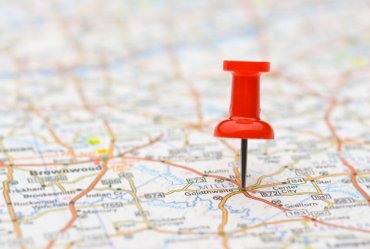Whether or not you’re a fan of the ever-increasing use of “roundabouts”, you’ll be surprised to know they may have a positive effect on auto insurance. If you’re unfamiliar with “roundabouts”, you’re probably wondering what they are and, how in the world do they have anything to do with your auto insurance.
Let’s start by saying that they’re fairly commonplace in other countries throughout the world, especially in Europe, where cars circle around a central island, which is essentially an intersection with several outlet streets. And, as far as what positive effect they might have – in areas where they’re being used, roundabouts have led to a reduction in traffic delays, accidents, fuel consumption, and air pollution, not to mention construction costs. In addition, proponents of their use claim they’re a more aesthetically pleasing form of intersection that can accommodate a higher capacity of traffic, while increasing the flow.
In cities around the U.S., roundabouts are popping up due to the fact that many of their fans believe they make a difference and requests to help reduce street traffic congestion are going up. And, as a result of the demand, insurance companies are looking closer into whether the difference in costs and increased safety can help reduce auto insurance premiums of drivers in areas where they’re being used or constructed.
While drivers who use them in their cities on a regular basis can navigate them safely without too much effort, they can be somewhat confusing at first to those unfamiliar with the concept.
There are both advantages and disadvantages associated with the use of roundabouts. Below are just a few of those:
Advantages:
1. Traffic flow – The idea of the roundabout is to keep the flow of traffic constantly moving in a singular direction, rather than stopping it at red lights. The end result is that traffic doesn’t bottle up as it would if stopping at a stop sign or at a red light, thereby, easing congestion.
2. Fuel consumption – This one should immediately get your attention. The fact that vehicles continue to move, there’s no need to idle unnecessarily while waiting for a red light to turn green. No waiting translates into better fuel mileage.
3. Air pollution – Associated with increased fuel mileage is the reduction of pollutants, such as carbon monoxide, released into the air from the exhaust of automobiles and trucks.
4. Cost – Because these types of intersections are much less expensive to build and maintain, they make sense for cities looking to keep expenses down.
5. Overall Safety – According to a study conducted by the Institute of Transportation Engineers, from the yield line of a roundabout, motorists are forced to travel more slowly, and maneuver a total of 4 decision points until they can complete their exit. However, at a four-way stop sign, there are a possible 24 decision points faced by drivers throughout its use. Ideally, the fewer decision points, the lower the risk of accidents, leading to a potential reduction in auto insurance rates.
6. Attractiveness – Aesthetically speaking, roundabouts are more attractive than four-way stop signs or traffic light intersections. Many roundabouts are landscaped with grass or flowers. Others are not, but their appearance is still more pleasing to the eye.
Disadvantages:
1. Transitional period – Learning a new type of intersection, one you may have never used before, means developing the skills to get around it. After the initial confusion, poor decision making, and possible accident…once you get the hang of it, you’ll find roundabouts to be quite easy to use.
2. Loss of business – Location, location, location. When choosing a site to make a business successful, location is everything. Companies rely on exposure at nearby intersections while drivers stop and wait, and inadvertently look around. However, motorists are less likely to notice posted advertising or signs while using roundabouts. This could lead to lost revenue.
3. Multi-lane roundabouts – Single-lane roundabouts have been shown to definitely reduce accidents. On the other hand, multi-lane roundabouts can be somewhat more problematic as drivers find them slightly harder to navigate.
In the end, the verdict is still out as to whether roundabouts pose potentially good news to drivers. With the reduction of traffic accidents as a result, drivers can only hope it’ll mean a corresponding drop in their auto insurance rates.
You don’t have to wait for a roundabout in order to save money on car insurance. Freeway Insurance can offer you a wide range of affordable policies. Get a free car insurance quote online today!



